2013 Welthunger-Index : Herausforderung Hunger : Widerstandsfähigkeit stärken Ernährung sichern
Der Bericht zum Welthunger-Index 2013 – der achte in einer jährlich erscheinenden Serie – stellt die Entwicklung des weltweiten, regionalen und nationalen Hungers mittels eines mehrdimensionalen Indexwertes dar. Er zeigt, dass die Weltgemeinschaft bei der Bekämpfung des Hungers seit 1990 gewisse Fortschritte gemacht hat, dass aber noch viel zu tun ist.





